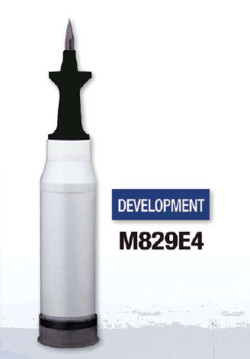US to demilitarise 78,000 depleted uranium tank rounds
On May 6th the US Army announced the winning contract for the demilitarisation and disposal of a large stockpile of ageing DU ammunition. While not made clear in the contract award, the stockpile is thought to comprise of a mixture of 105mm and 120mm ammunition:
C524 M833 105mm,
C543 M900 105mm,
C380 M829A1 120mm,
C792 M829A2 120mm.
As befits the beneficial circularity of US defence contracting, General Dynamics, the winner of the US$12m contract, had originally manufactured and sold some of the 120mm rounds to the US Army.
The M833 and M900 rounds entered service in 1983 and 1989 respectively, with the M900 superseding the M833. The M833 was originally designed for use by the M1 Abrams and M60 Patton tanks, with the M900 cleared for use in the M1 Abrams and Stryker Mobile Gun System. Both rounds were exported widely during the 1990s, with NATO members and states with Major Non-NATO Ally status eligible.
 Later versions of the M1 Abrams abandoned the 105mm main gun, this was replaced with a 120mm gun that used the M829 round. The A1 and A2 were early variants and have now been superseded by upgrades. Test firing of the current developmental upgrade, the fifth generation version – the M829E4 - has taken place this year. Following the tests Lt. Col. Brian Gruchacz, product manager for Large Caliber Ammunition was reported as saying that: "The M829E4 adds capability to the Abrams system without adding responsibility." ICBUW presumes that he was referring to the alleged overmatch capability of the round, rather than the legacy of contamination it leaves on both range and battlefield.
Later versions of the M1 Abrams abandoned the 105mm main gun, this was replaced with a 120mm gun that used the M829 round. The A1 and A2 were early variants and have now been superseded by upgrades. Test firing of the current developmental upgrade, the fifth generation version – the M829E4 - has taken place this year. Following the tests Lt. Col. Brian Gruchacz, product manager for Large Caliber Ammunition was reported as saying that: "The M829E4 adds capability to the Abrams system without adding responsibility." ICBUW presumes that he was referring to the alleged overmatch capability of the round, rather than the legacy of contamination it leaves on both range and battlefield.
The US Army is set to buy 2501 M829E4 rounds this year for its war reserves at a cost of US$30.168m, or US$10,100 each. The rounds will be manufactured and sold by Alliant Tech Systems. Coincidentally, US$30m was the lower estimate for the cost of decontaminating the 350 known DU impact sites in Iraq.
Once demilitarised, the fate of the DU metal from the penetrators is unclear. DU is alloyed with small quantities of titanium or molybdenum when used as penetrators, if the alloys are still appropriate for the new generation rounds they may be recycled, if not they will become part of the US’s vast stockpile of waste DU, necessitating indefinite storage as Intermediate Level Radioactive Waste. Other parts of the weapon assemblies, such as the aluminium sabot petals will need to be disposed of as Low Level Radioactive Waste.
For more information on the perceived utility of large calibre tank rounds read our report Overstating the Case.




